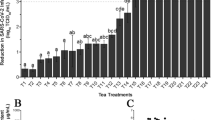Abstract
It was shown that barley coffee (BC) interferes with Streptococcus mutans adsorption to hydroxyapatite. After BC component fractionation by dialysis and gel filtration chromatography (GFC), it was found that the low molecular mass (<1,000 Da) fraction (LMM fraction) containing polyphenols, zinc and fluoride ions and, above all, a high molecular mass (HMM > 1,000 kDa) melanoidin fraction display strong anti-adhesive properties towards S. mutans. In this study, we have further examined the potential of BC, BC LMM fraction and BC HMM melanoidin fraction as caries controlling agents by evaluating their anti-biofilm activity.The effects of BC and BC fractions on biofilm formation by S. mutans ATCC 25175 and its detachment from pre-developed biofilms were evaluated by microtiter plate assay. It was found that BC and its fractions, at concentrations ranging from 60 to 15 mg ml−1 that are devoid of antimicrobial activity, inhibited S. mutans biofilm formation. An increase of S. mutans ATCC 25175 detachment from 24 h developed biofilm was observed at the highest tested concentrations. Interestingly, BC and BC fractions also showed anti-biofilm activity towards a variety of S. mutans clinical strains isolated from saliva, plaque and caries lesions of adult donors. In general, the HMM melanoidin fraction was more active than the LMM fraction. These findings, classifying BC LMM fraction and BC HMM melanoidin fractions as natural anti-biofilm agents, represent the basis for studying their possible use as anti-caries agents.



Similar content being viewed by others
References
Bodet C, Grenier D, Chandad F, Ofek I, Steinberg D, Weiss EI (2008) Potential oral health benefits of cranberry. Crit Rev Food Sci Nutr 48:672–680
Bowden GH (1995) The role of microbiology in models of dental caries, Reaction paper. Adv Dent Res 9:255–269
Bradshaw DJ, Marsh PD (1998) Analysis of pH-driven disruption of oral microbial communities in vitro. Caries Res 32:456–462
Brailsford SR, Lynch E, Beighton D (1998) The isolation of Actinomyces naeslundii from sound root surfaces and root carious lesions. Caries Res 32:100–106
Chen Z, Saxena D, Caufield PW, Ge Y, Wang M, Li Y (2007) Development of species-specific primers for detection of Streptococcus mutans in mixed bacterial samples. FEMS Microbiol Lett 272:154–162
Daglia M, Tarsi R, Papetti A, Grisoli P, Dacarro C, Pruzzo C, Gazzani G (2002) Anti-adhesive effect of green and roasted coffee on Streptococcus mutans adhesive properties on saliva coated hydroxyapatite beads. J Agric Food Chem 50:1225–1229
Daglia M, Papetti A, Grisoli P, Aceti C, Spini V, Dacarro C, Gazzani G (2007) Isolation, identification, and quantification of roasted coffee antibacterial compounds. J Agric Food Chem 12:10208–10213
Feldman M, Weiss EI, Ofek I, Steinberg D (2009) Interference of cranberry constituents in cell-cell signaling system of Vibrio harveyi. Curr Microbiol 59:469–474
Ferrazzano GF, Amato I, Ingenito A, De Natale A, Pollio A (2009) Anti-cariogenic effects of polyphenols from plant stimulant beverages (cocoa, coffee, tea). Fitoterapia 80:255–262
Fux CA, Costerton JW, Stewart PS, Stoodley P (2005) Survival strategies of infectious biofilms. Trends Microbiol 13:34–40
Gilbert P, Das J, Foley I (1997) Biofilm susceptibility to antimicrobials. Adv Dental Res 11:160–167
Kelly CG, Younson JS (2000) Anti-adhesive strategies in the prevention of infectious disease at mucosal surfaces. Expert Opin Investig Drugs 9:1711–1721
Lambert JD, Kwon SJ, Hong J, Yang CS (2007) Salivary hydrogen peroxide produced by holding or chewing green tea in the oral cavity. Free Radic Res 41:850–853
Li YH, Hanna MN, Svensäter G, Ellen RP, Cvitkovitch DG (2001) Cell density modulates acid adaptation in Streptococcus mutans: implications for survival in biofilms. J Bacteriol 183:6875–6884
Liljemark WF, Bloomquist C (1996) Human oral microbial ecology and dental caries and periodontal diseases. Crit Rev Oral Biol Med 7:180–198
Marsh PD, Bradshaw DJ (1999) Microbial community aspects of dental plaque. In: Newman H, Wilson M (eds) Dental plaque revisited, oral biofilms in health and disease. Bioline, Cardiff, UK, pp 237–253
Matsumoto M, Minami T, Sasaki H, Sobue S, Hamada S, Ooshima T (1999) Inhibitory effects of oolong tea extract on caries-inducing properties of mutans streptococci. Caries Res 33:441–445
Ofek I, Hasty DL, Sharon N (2003) Anti-adhesion therapy of bacterial diseases, prospects and problems. FEMS Immunol Med Microbiol 38:181–191
Otake S, Makimura M, Kuroki T, Nishihara Y, Hirasawa M (1991) Anticaries effects of polyphenolic compounds from Japanese green tea. Caries Res 25:438–443
Papetti A, Daglia M, Aceti C, Quaglia M, Gregotti C, Gazzani G (2006) Isolation of an in vitro and ex vivo antiradical melanoidin from roasted barley. J Agric Food Chem 54:1209–1216
Papetti A, Pruzzo C, Daglia M, Grisoli P, Bacciaglia A, Repetto B, Dacarro C, Gazzani G (2007) Effect of barley coffee on the adhesive properties of oral streptococci. J Agric Food Chem 55:278–284
Schüpbach P, Osterwalder V, Guggenheim B (1996) Human root caries, microbiota of a limited number of root caries lesions. Caries Res 30:52–64
Senadheera D, Cvitkovitch DG (2008) Quorum sensing and biofilm formation by Streptococcus mutans. Adv Exp Med Biol 631:178–188
Smullen J, Koutsou GA, Foster HA, Zumbé A, Storey DM (2007) The antibacterial activity of plant extracts containing polyphenols against Streptococcus mutans. Caries Res 41:342–349
Steinberg D, Feldman M, Ofek I, Weiss EI (2004) Effect of a high-molecular-weight component of cranberry on constituents of dental biofilm. J Antimicrob Chemother 54:86–89
van Houte J (1994) Role of micro-organisms in caries. J Dent Res 73:672–681
Weiss EI, Lev-Dor R, Kashamn Y, Goldhar J, Sharon N, Ofek I (1999) Inhibiting interspecies coaggregation of plaque bacteria with a cranberry juice constituent. J Am Dent Ass 129:1719–1723
Wen ZT, Suntharaligham P, Cvitkovitch DG, Burne RA (2005) Trigger factor in Streptococcus mutans is involved in stress tolerance, competence development, and biofilm formation. Infect Immun 73:219–225
Acknowledgement
This study was supported by PRIN grant from the ‘Ministero dell’Università e della Ricerca’, Roma, Italy.
Author information
Authors and Affiliations
Corresponding author
Rights and permissions
About this article
Cite this article
Stauder, M., Papetti, A., Daglia, M. et al. Inhibitory Activity by Barley Coffee Components Towards Streptococcus Mutans Biofilm. Curr Microbiol 61, 417–421 (2010). https://doi.org/10.1007/s00284-010-9630-5
Received:
Accepted:
Published:
Issue Date:
DOI: https://doi.org/10.1007/s00284-010-9630-5




